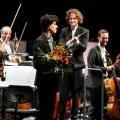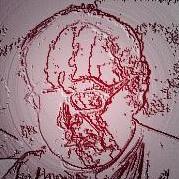Search the Community
Showing results for tags 'duo'.
-
-
This work was written for a call for works for violin and cello duo. An episode is a form that I created a few years ago. The concept behind the form stems from my love of contrapuntal textures. For this form, which I've explored more within my piano writing, the concept is the weaving of contrapuntal textures and more homophonic explorations of the material -similar to the estampie model of the renaissance. This would be the first episode that I've composed outside of my piano works -so, to me, this work is an excellent embarking of the form to other genres! Anyways, I'll be revising this piece based off the performance -should it manifest! Hope you enjoy.
-
I wanted to share this little piece composed by a friend of mine and me, two years ago, for Christmas. It was inspired by the facts taking place in World War I, when there was a spontaneous truce in Belgium. Each band (English and German) started to sing Silent Night in their own languages, the fighting was stopped, and they even shared gifts and hugs. The next day they buried the fallen soldiers... (Sorry, in the score it is explained in Spanish).
-
Hello, I composed this little piece in response to a challenge on the forum to write for a combination of two instruments based on your birthday date. At the same time, I used this piece for an exercise, I gave myself: write a piece in less than 15 minutes. My combination was the Violin and the Horn (in F). I tried to keep the atmosphere very light, yet interesting. The music has to be funny, because it is a 'birthday song,' so therefore the Allegro scherzando and no very heavy harmonies. Sharing your thoughts is very appreciated! Maarten
-
Sonatina for a duo of Clarinet and Viola
- 1 reply
-
- chamber music
- duo
-
(and 4 more)
Tagged with:
-
Hi all, Since this year I am doing the pre-study of the conservatory. For the people who do not know yet: I play alto (and soprano) saxophone (classical). I met a hornist of the same age and we can get along with each other very well. We decided to form a duo. Until now I have transcripted (or transposed at sight) all our music (Mozart Horn Duets, Bach Inventions, Otto Nicolai duets etc.). The problem is that, although saxophone works ''fine'' replacing a horn, it is not comfortable to play music that is not originally written for this special duo. My question is if you know some saxophone (preferably alto) & horn duo repetoire. If so, please tell me the composer and title of the composition! We are both receptive to new compositions, so feel free to write for us. (Please post in the Upload Section). Kind regards, Maarten
-
Duo Sonate - For Two Bassoons Composer: Sophia Gubaidulina I first heard the work of Gubaidulina late one night while perusing concerti on YouTube. The piece that caught my eye was her Viola Concerto. I wasn't necessarily familiar with her music, but was very familiar with the violist performing it. The music left me breathless. The structure, the pacing, the harmonic language, the orchestration, and the treatment of the solo line all were very well done. It was from this piece that my deep love of her music grew immensely. When asked to research composer's works for the composition lesson, I quickly chose Gubaidulina. The work I chose, sadly, wasn't the viola concerto but instead a smaller chamber work: . In this analysis, I will look at the structure of the piece.In looking at the score in depth, I was quite surprised to find that the form is quite traditional: sonata form. The reason for the surprise comes in the techniques used in the bassoons: flautando, multiphonics, harmonics, and microtones. Granted, these shouldn't immediately dismiss the possibility of a traditional form being used to structure a piece. The formal sections are: -the introduction lasts from the opening to rehearsal mark 2. -the exposition from rehearsal mark two to the Grand Pause that precedes rehearsal mark 13. -the development from rehearsal mark 13 to the grand pause that precedes rehearsal mark 31. -the recapitulation from from rehearsal mark 31 to roughly rehearsal mark 35. -the coda from rehearsal mark 35 to the end. The exposition breaks into roughly 5 subsections of interest. The first is from rehearsal mark 2 through rehearsal mark 5. This subsection is the first theme of the work. The second is from rehearsal mark 5 through rehearsal mark 6. This short passage, at first, appeared to be inconsequential or transitional in nature. It wasn't until the development section that I realized this was actually a second theme. The next subsection is a return to an altered version of the first theme.This starts at rehearsal mark 6 and lasts through rehearsal mark 9. At rehearsal mark 9, a variation of the overall texture acts as a transition and build up to the final subsection which starts at rehearsal mark 12. This final subsection lasts up till the grand pause right before rehearsal mark 13. In classic sonata form, the development starts with a restatement of the themes presented in the exposition. The first theme is stated at rehearsal mark 13. After the restatement, the development quickly begins. The development occurs in three subsections. The first subsection starts at rehearsal mark 14 and lasts through rehearsal mark 15. In this section the second theme is developed. Underneath the first theme is broken up and used as support. The second subsection is from rehearsal mark 15 through rehearsal mark 22. In this section the development of the first theme occurs. Interwoven in this, for means of temporal movement, is the introductory scalar material in inversion. The final subsection starts at rehearsal mark 22 and lasts until the grand pause right before rehearsal mark 31. In this section the second theme is absorbed into the scalar material and expanded to present a long scale that rises slow at first and faster until it reaches the grand pause. The recap and coda follow the second grand pause. The recapitulation starts at rehearsal mark 31 and lasts through rehearsal mark 35. Here though the first theme is the only one restated, albeit in an altered version. The coda starts at around rehearsal mark 35 and lasts until the end of the piece. The material treated here is the scalar material from the introduction. The material is treated with several developmental techniques. Most notable is diminution and augmentation of the note values. Overall, I learned a great deal in analyzing the work in this way. I've greatly admired nearly every piece I've heard by Gubaidulina. This piece showed me a great genius behind her compositions and showed me several new things that I previously did not know that bassoonists could do (multiphonics and harmonics). I look forward now to breaking apart more of her works.






